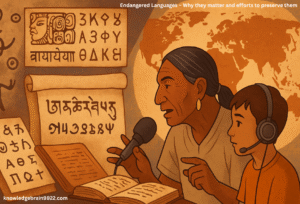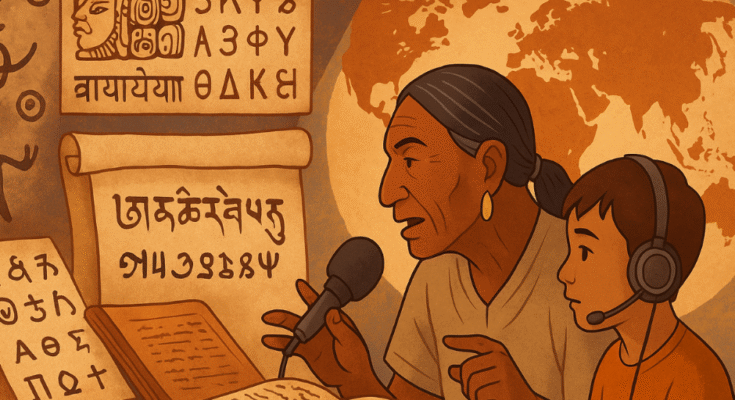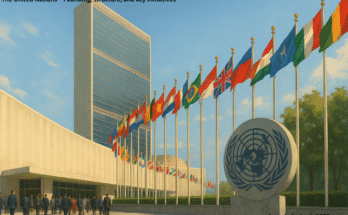
The Significance of Endangered Languages and Their Preservation Efforts Overview
They represent the culture perspectives, values, and wisdom of entire societies and are more than mere means of communicating. Yet, each language is wiped out every two weeks, when the final speaker dies. About 40% of the languages that are spoken around the world are in the danger of disappearing today. The social fabric, the ecological understanding culture, expressions of the past, as well as distinct oral histories, go extinct along with language. The importance of endangered languages is covered, along with the reasons for loss of language and the many initiatives of groups, academics, as well as authorities to protect and encourage language diversity.
The Benefits of Diversity in Linguistics
Identity and Cultural Heritage
Folklore, culture-specific customs and memories shared by the entire community are recorded in different languages. They are intrinsically tied to their customs, proverbs songs, and customs. Languages’ distinctive metaphors ethics, moral precepts, as well as histories all vanish as it goes, destroying community identity and continuity across generations.
Knowledge of Ecology
The detailed classification of the native fauna, flora and ecosystems is often seen in indigenous language. Languages, oral stories and terms are inspirated by traditional ecological wisdom, including animals’ behaviours as well as seasonal cycles and the use of medicinal plants. Because modern science tends to ignore indigenous ecological perspectives and practices, a loss of indigenous traditional languages could undermine conservation of biodiversity and sustainable resource management. conservation.
Scientific and Cognitive Perspectives
In order to understand the adaptability of humans’ cognitive abilities, linguists and cognitive scientists study a range of grammatical and phonetic structure. Theories regarding the development of language, neuroplasticity and cognitive processing are supported by the distinct ways in which each language encodes time spatiality, and connections. The research on all aspects of human cognition is hindered because of the absence of language variation.
World Heritage
Languages are classified by their vitality in the Atlas of the languages of the world in danger. Loss of a group’s spoken language erodes the rich cultural heritage and undermines the diversity of human genius that’s kept alive in narrative, poetry music, and narrative. The preservation of unique species within nature reserves is like protecting endangered languages.
Language Endangerment Causes
Globalisation and Language Dominance
The mass media, urban mobility and economic integration are in favor of English, Mandarin, and Spanish over all other minorities languages. The transmission of native languages is often unintentionally diminished when parents force their children to master the predominant language to boost their chances in employment and education.
Historical and Political Aspects
Languages of minority and indigenous peoples were marginalised because of the constant imposing of official languages during the period of colonialism as well as nation-building. The stigmatisation of indigenous languages was a major factor, and intergenerational acquisition of languages was affected by forced methods of assimilation such as language homogenisation within postcolonial government as well as residential schools in Canada as well as Australia.
Social and Economic Forces
Community members are forced to abandon their ancestral language due to poverty, discrimination as well as an absence of assistance from the government. Languages of minorities lose their value and value due to the lack of institutional incentives, financial aid or acceptance from institutions like the judiciary, the media and the schools, speeding the shift to more dominating languages.
Changes in the Environment and Demographics
Indigenous people are forced out of their ancestral lands due to the effects of climate change, resource extraction and loss of land. When diaspora communities adjust to the language of their new country and move out, they break up the groups of people who speak a language. In the event of pandemics, or other social disruptions, smaller groupings of speakers are more at risk.
Language Loss’s Effects
Cultural Practices’ Erosion
If customs for gathering, ceremonies and agricultural rites translate into the majority of language, they often disappear or are inaccessible. Elders who die do not pass onto the next generation the key words to rituals and significance, their cultural insecurities decrease.
Social and Psychological Repercussions
Identity disorientation, trauma from the past and low self-esteem can be the most common causes of loss of language. The close connection between the tongue and the psyche is emphasized through studies of Indigenous groups. These studies show that the regaining of language can boost resilience social pride, community spirit, and improves mental health.
Science and Medical Knowledge Gaps
The essential ethnobotanical information is lost if there is no one who can explain the meaning of ecological terms, or chants for healing from the past. Plans for adaptation to climate change as well as research in the field of pharmaceuticals are deprived of the specific knowledge of communities that could aid in the development of new therapies and environmentally-friendly methods.
Methods for Preserving and Revitalising Documentation: Capturing Texts and Voices
As part of communities they use field linguists’ audio and video recordings to record conversations, tales as well as songs of native language speakers. They serve as the basis of dictionaries, archives of languages and grammars. All of these are vital instruments for students as well as researchers. The fieldwork of these researchers is funded worldwide by various programs, including the Endangered Languages Documentation Programme (ELDP) which is located at SOAS, University of London.
Classrooms Run by the Community and Immersion Initiatives
Originally founded in Maori and Hawaiian revitalization, language nests – early children’s immersion schools–have exploded across the globe. Children are instructed in the language of their heritage by their elders and native speakers. This promotes natural learning. Through the pairing of students with elders who speak fluently like Master-Apprentice programs, similar models involve students in everyday conversation and contextual contexts.
Digital Tools and Technology
Online dictionaries, E-Learning platforms and mobile apps allow for democratisation of accessibility to resources for language. Technologies are used to facilitate remote learning, in projects like the Endangered Languages Project’s online archives as well as the Living Tongues Institute’s Talking Dictionaries. Diaspora speakers are able to connect to exchange tuition and also broadcast storytelling sessions across the world by joining social media communities as well as YouTube channels.
Literature, the Arts, and Media
Publishing children’s and poetry books and newspapers that are written that are in languages of endangered species increases awareness and increases literacy. The television shows, podcasts and radio shows all allow usage of languages in public places. The music and movies that speak native languages increase pride and inspire young people to become more involved. Te Reo Maori, a Maori-language TV channel is crucial for the continued existence of Te Reo throughout New Zealand.
Reforming Education and Policy
The laws on the rights of language that allow minorities in signs, legal systems as well as in education, can be enacted by municipal and national government officials. In the production of material and teacher training programs as well as bilingual curriculums ensure the continuous inclusion of endangered languages in classrooms. Indigenous peoples’ rights to protect, use and develop their language is protected by the UN Declaration on the Rights of Indigenous Peoples (UNDRIP).
Networks and Collaborative Research
Conferences, workshops as well as policy debates are organized by groups like UNESCO, SIL International, as well as the Alliance for Linguistic Diversity. They help facilitate exchange of good strategies for funding, practices as well as resource materials among linguists and educators, lawmakers, and community leaders. Working together across disciplines–education, sociology, and anthropology–produces comprehensive strategies catered to the need of any community.
Examples of Cases
Hawaiian (Hawai`i `Olelo)
With only 50 native speakers, Hawaiian was in danger of becoming extinct in the mid-’60s. Hawaiian school of immersion (Kula Kaiapuni) and `Aha Punana Leo language nests marked the start of grassroots projects during the 1970s. This decline was stopped by inclusion into public schools, and official recognition under The 1978 Hawaiian Language Act. The language of today is flourishing within the government, media and in daily life with more than 24,000 children are enrolled in immersion programs.
Japan’s Ainu
In the beginning of 2000 it was not the case that there were any native people speaking northern Japan’s Ainu spoken language. The development of dictionaries along with college courses and celebrations in regional areas are all instances of a recent revival. In 2008 in 2008, the Japanese government recognized Ainu to be “indigenous people,” which has increased the funding available for cultural activities and instruction in language. Ainu students now teach classes that focus on the traditional language of song and speech and are paving the way for transgenerational exchange, despite the reality that they remain at risk of being extinct.
United States’ Yuchi
In the year 2019, Yuchi, a language spoken in the eastern part of Oklahoma has fewer than ten elder speakers. In the direction by linguists, activists and elders of the community and community elders, the Yuchi Language Project provides weekly sessions, camps of immersion as well as an Talking Dictionary, and an orthography specifically for Yuchi phonetics. An important portion of the Muscogean language heritage is conserved through partnerships in conjunction with Florida State University and the University of Oklahoma, which examine grammar and vocabulary.
(United Kingdom) Welsh
Legally binding bilingual legislation, Welsh-speaking schools and other media, such as for instance the S4C television channel contributed to revitalize Welsh that was restricted to rural Wales and a declining number of speakership (1982). Digital media such as public services, digital material, as well as signage for Welsh increased the use of Welsh. In fact, even major-language areas are benefited by a supportive policy and community involvement which is evident by the statistic that 29percent of Welsh people can communicate in the language today and that enrollment in immersion schools is growing.
Obstacles and Things to Think About
Limitations on Resources
The support of the community, linguistic experts who are skilled as well as consistent financial support is essential to document and revival. Problems with logistics include isolation and unstable political climates and a lack of infrastructure. The initial fieldwork can be supported by grants from government organizations and foundations for philanthropy however long-term projects might not receive the support it needs.
Innovation and Tradition in Balance
Code-switching, social media slang as well as borrowed terms are all examples of styles created through modernisation, which can revitalize language and accelerate the detachment from their old ways of thinking. The programs must balance the need for keeping the classical registers that are vital for authenticity in culture as well as adapting to the changing times.
Community Control and Intellectual Property
Access and ownership issues have been raised in digital archives. Access control over who has access to sacred stories, private rituals or holy rites is something many communities would like to have. In collaboration with leaders of the community ethics procedures ensure that documents are geared towards local needs, and secure private data.
Assessing Achievement
Research on long-term duration is essential to determine revitalisation metrics like the amount of speakers and frequency of usage as well as intergenerational transmission. To assess the effectiveness and direct future initiatives in the future, both quantifiable information (enrolment figures, hours recorded) as well as qualitative assessments (community satisfaction, participation in culture) are needed.
The Path Ahead: Empowering Young People
The adaptation of languages that are endangered to the modern world is made possible by utilizing young people as ambassadors for culture as app developers, developers and digital storytellers. Contests for songwriting, TikTok campaigns, and youth-led hackathons for languages can transform the focus of revitalisation from an obligation to a creative endeavor.
Including Language in Sustainable Development
It is important to note that the Sustainable Development Goals (SDGs) 4 (Quality Education) and 10 (Reduced inequalities) and 16 (Peace as well as Justice and Solid Institutions) all have to do with the goal of preserving languages. The intrinsic value of linguistic variety is shown through the inclusion of rights to linguistics when it comes to economic management, planning as well as education.
International Funding and Solidarity
International frameworks help mobilize political power and funds, for instance the UN’s International Decade of Indigenous Languages (2022-2022). The accountability of local authorities are strengthened by collaborative financing methods, such as funding matching for community-driven projects.
In the end
The loss of a language is the permanent loss of an archives of human knowledge of culture, history, and tradition. Yet, the amazing accomplishments of initiatives across the globe from Hawaii to Wales prove that revitalization is possible when linguists government agencies, international organizations, and local communities collaborate. There is a way to restore the strength and vitality of languages that are endangered by implementing documentation, immersion programs technological advancements, as well as regulatory adjustments. The preservation of linguistic diversity is a moral responsibility to protect the voice of every community and preserve humanity’s shared heritage It is not just a research project.



